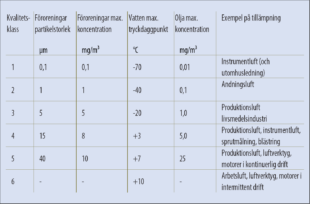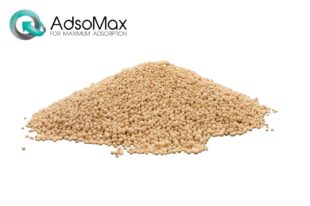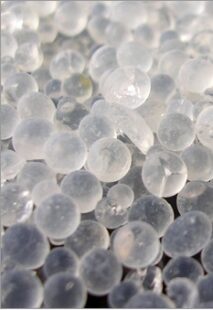All air contains water. In both hot summer days and cold winters, the air contains water, the difference between hot and cold air is the amount of water in the air. The colder the air, the less water it can hold. This can be illustrated, for example, on an early summer morning when the grass is damp even though there are no clouds or rain on the day or night. During the day, the air is warm, which means that the air binds and carries more moisture compared to nighttime when the temperature drops and the air is unable to retain the water content. This means that the air precipitates water that settles in the grass, for example.
The next factor that limits the air's ability to carry moisture is compression. Air and gas can be compressed, unlike water, which means that when the air is compressed, more air and water are collected in a maintained volume. Since the air sucked into a compressor contains water that cannot be compressed, the proportion of water in the compressed air increases. The air, which cannot carry that much more water, then precipitates water (the dew drops on the grass early in the morning).
In a compressed air system, the compressor compresses the air it sucks in and pumps it on to an air tank. The air tank has a drain valve that releases the proportion of water that the air cannot carry with it after compression and that has collected at the bottom of the tank.
After the compression stage, the compressed air usually needs to be dried even more. The amount of moisture that remains in the compressed air will continue to precipitate more water droplets if the pressure increases even more and/or if the temperature of the compressed air drops. For different types of processes, the requirements for the water content (dew point) are different. This table shows different types of air classes acc. ISO 8573 for compressed air classes.

In the table you can see that the lowest limit for compressed air used by, for example, car workshops, tire workshops or other businesses where, for example, there are no instruments where measurement etc. is damaged by the moisture content still has a dew point requirement of a maximum of +10°C. The reason for this is that if you have a maintained pressure of, for example, 7 bar in the system, the air will still precipitate water after the compressor as the air will be cooled down to the ambient/indoor temperature +20°C. This means that pipelines and work tools are always exposed to moisture, which has a major impact on service life. Rusty air lines with rust particles in the tools are a common problem with completely undried air. If the air duct should then have a certain distance outdoors (between buildings etc.), the duct will quickly freeze again and it will stop during the winter months when the outdoor temperature drops below zero.
In simpler operations for working air and production air that do not meet any special requirements for air content, a so-called refrigeration dryer is used for drying. It works like a refrigerator where the air is cooled and thus the air precipitates water and is then heated again as "dry" air after drying. This type of drying gives a dew point down to +3°C. This means that as long as the air maintains a temperature above +3°C (and does not increase in pressure), it will not precipitate more air. This means that if the air line is partially located outdoors, even simpler operations will need more advanced drying equipment to prevent freezing of the air line.
For operations using production air (where moisture is devastating to product production), breathing air or more advanced instrument air, adsorption drying of compressed air is needed. Adsorption drying (AD drying) differs significantly from refrigeration drying in that an adsorption dryer (AD dryer) is used instead. In an AD dryer, the air flows through a container filled with desiccant. Desiccant are small beads that adsorb moisture as air passes through. Adsorption dryers usually have two containers filled with desiccant and work in cycles. In one drying cycle, the air is dried through one container while the desiccant in the other container is dried, and vice versa in the other drying cycle.
The desiccant in the adsorption dryer needs to be changed at regular intervals as it loses its adsorption capacity over time. Often the replacement intervals are between 4-6 years depending on the type of drought. It is important then that you choose a drying agent of good quality so that you do not have to carry out a change prematurely.

AdsoMax Molecular Sieve
AdsoMax desiccant for adsorptiondryers is an example of a desiccant that Kompauto Nordic AB markets and delivers to process industries in Europe. AdsoMax maintains the highest quality for both service life and adsorption capacity, which is a prerequisite for achieving high cost-effectiveness. AdsoMax desiccants are available in the most common desiccant types used for drying compressed air, process gas, natural gas and biogas. Types such as Silica Gel, Molecular Sieve and Activated Alumina (Alumina).

AdsoMax Silica Gel




